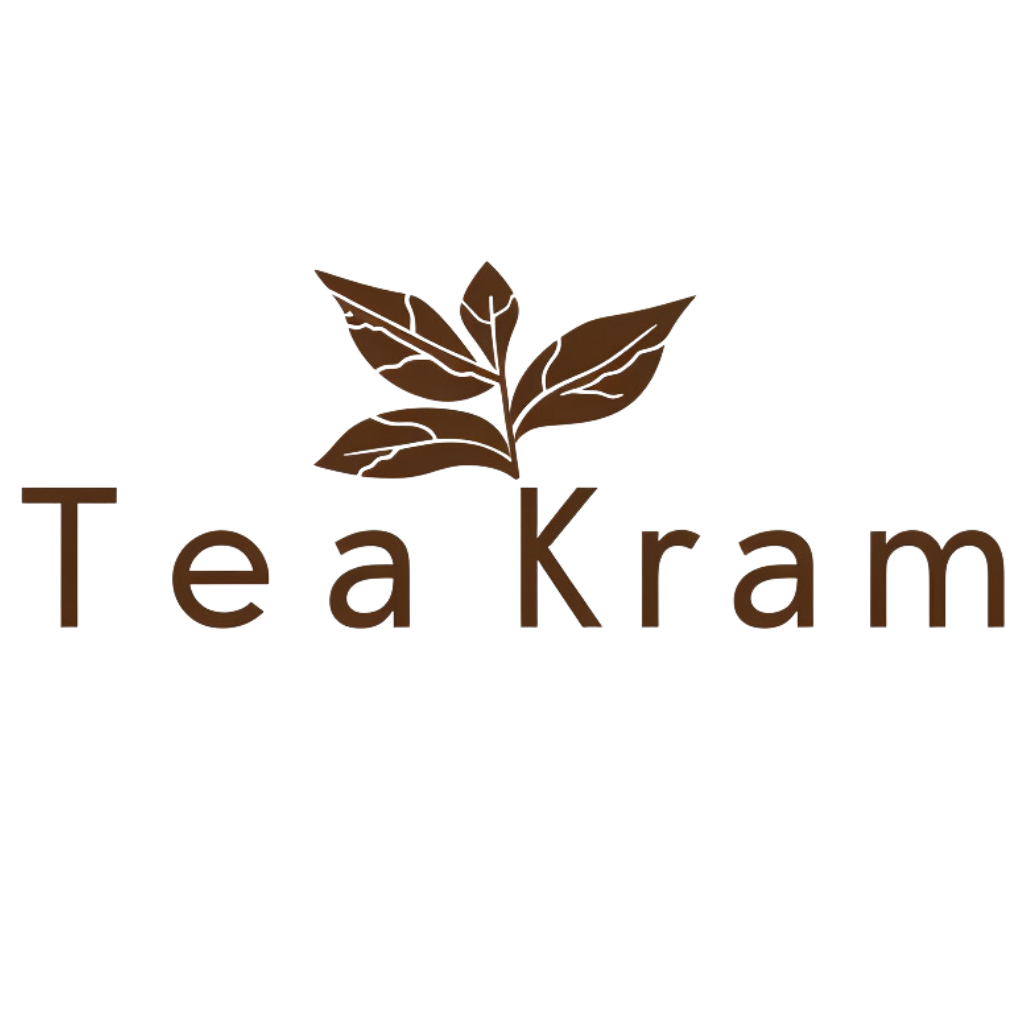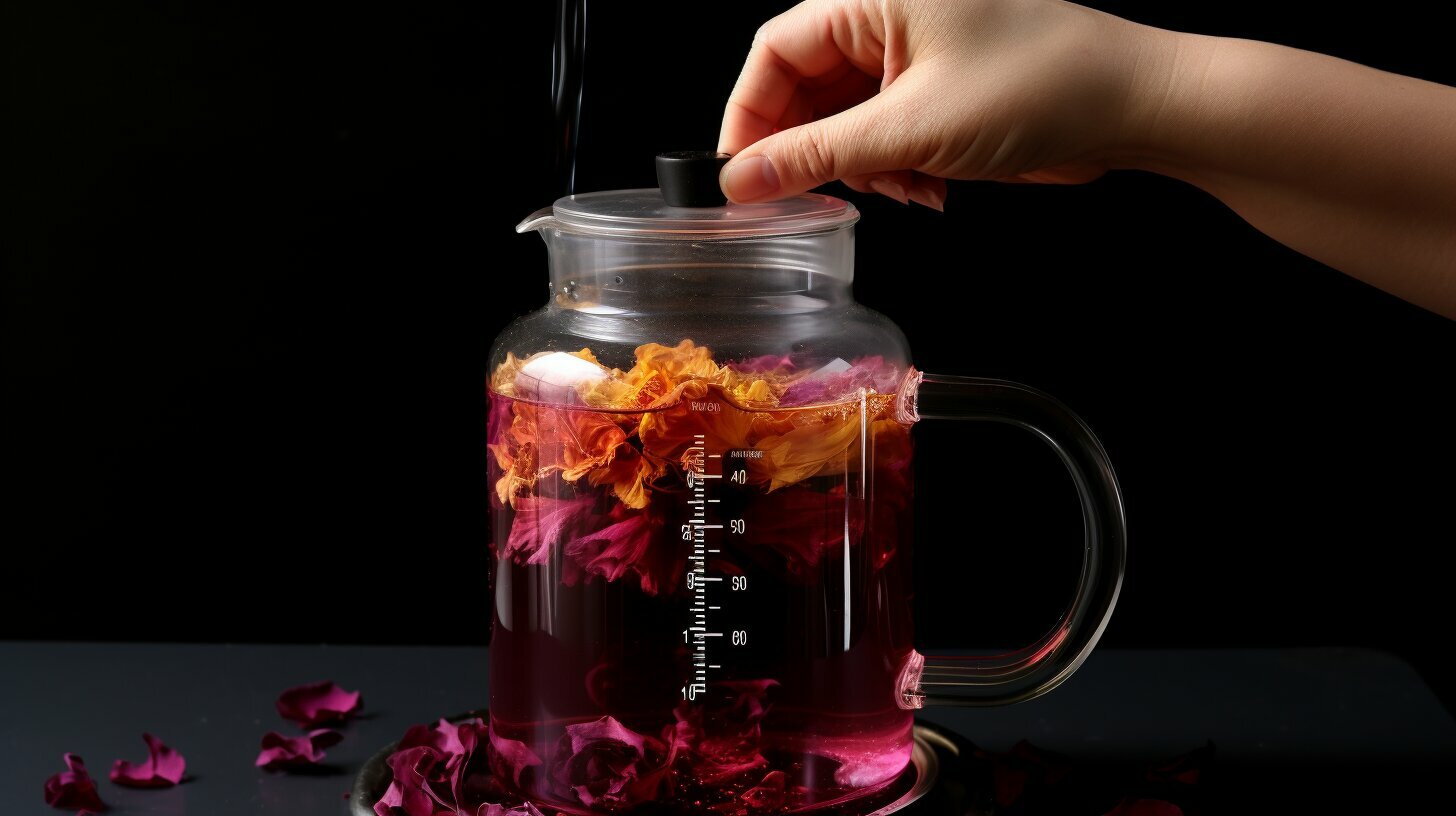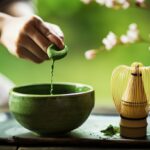Are you looking for a refreshing and healthy beverage to enjoy at home? Look no further than hibiscus tea. This delicious drink is easy to make and offers numerous health benefits. In this section, I’ll share with you a simple and easy step-by-step guide on how to make hibiscus tea at home. From selecting ingredients to brewing techniques, you’ll learn everything you need to know to make a perfect cup of hibiscus tea.
Key Takeaways
- Learn how to make hibiscus tea from home with this step-by-step guide.
- Discover the health benefits of hibiscus tea and how it can be a great addition to your daily routine.
- Understand the role of hibiscus flower in making hibiscus tea and how it adds to the flavor and color of the beverage.
- Get tips and tricks on how to prepare and serve hibiscus tea to enhance the taste experience.
- Learn about the potential side effects of hibiscus tea and how to consume it safely.
Benefits of Hibiscus Tea
If you’re looking for a healthy and flavorful beverage, hibiscus tea is an excellent choice. This tea, made from the dried hibiscus flower, has numerous benefits for your overall wellbeing. Let’s take a look at some of the top benefits of hibiscus tea:
| Benefit | Description |
|---|---|
| Rich in antioxidants | Hibiscus tea is packed with antioxidants, which can help protect your body against damage from free radicals and reduce inflammation. |
| Potential weight loss aid | Studies have shown that hibiscus tea may help support weight loss by reducing body fat and increasing metabolism. |
| May lower blood pressure | Hibiscus tea has been shown to have a beneficial effect on blood pressure, with some studies indicating it may help lower both systolic and diastolic blood pressure. |
| May improve liver function | Some research has suggested that hibiscus tea may have a protective effect on the liver, reducing inflammation and improving overall function. |
| High in vitamin C | Hibiscus tea contains high levels of vitamin C, which is essential for maintaining a healthy immune system and supporting collagen production. |
With so many potential benefits, it’s no wonder that hibiscus tea has become a popular drink worldwide. So, why not try brewing a cup of this tasty and beneficial tea today?
Hibiscus Tea for Weight Loss
If you are looking to shed some pounds, incorporating hibiscus tea into your weight loss routine may be a wise choice!
Research suggests that hibiscus tea may aid in weight loss by reducing body fat and inhibiting the production of new fat cells. Additionally, the flavonoids and antioxidants in hibiscus tea can boost your metabolism, helping to burn calories more efficiently.
Drinking hibiscus tea can also help you feel fuller for longer periods, reducing the likelihood of overeating. This can be especially helpful for those who struggle with portion control or snacking between meals.
It’s important to note that while hibiscus tea may support weight loss efforts, it’s not a magic solution on its own. However, incorporating it into a healthy, balanced diet and exercise routine can be a great addition to your weight loss journey.
Hibiscus Flower Tea: The Key Ingredient
Without a doubt, the hibiscus flower is the heart and soul of hibiscus tea. Known for its bright and vibrant color, as well as its tangy and slightly sour flavor, the hibiscus flower lends itself perfectly to tea preparation and is a must-have ingredient for any homemade brew.
Rich in antioxidants and vitamin C, hibiscus flower tea has been utilized for centuries for its numerous health benefits, including its potential to lower blood pressure, improve digestion, and boost the immune system. With all these benefits, it’s no wonder that hibiscus flower tea has become a popular and widely consumed beverage around the world.
When selecting hibiscus flower tea for your homemade hibiscus tea, it’s essential to choose high-quality, organic flowers. These flowers should be bright and fresh, with a strong aroma that indicates their potency. You can find dried hibiscus flowers at health food stores and online retailers, and they make an excellent addition to any tea cupboard.
If you have a hibiscus plant in your garden, you may also choose to harvest the flowers for your tea preparation. Harvest the flowers in the morning when they are fresh and fully bloomed, and make sure to remove the stamens and other debris before drying or steeping.
The hibiscus flower is a versatile ingredient, and you can also experiment with combining it with other herbs and spices to create different flavor profiles. Some popular pairings include ginger, mint, and cinnamon.
Some commonly used hibiscus tea ingredients include:
| Ingredient | Description |
|---|---|
| Hibiscus flowers | The main ingredient that gives hibiscus tea its vibrant color and tangy taste. |
| Water | The base for steeping the hibiscus tea and creating the herbal infusion. |
| Sugar or honey | Used as a sweetener to balance the tartness of the hibiscus flowers. |
| Lemon or lime | Adds a refreshing citrus flavor to the tea and enhances the absorption of nutrients. |
| Ginger | Spicy and warming, ginger pairs well with the floral and tangy flavor of hibiscus tea. |
Now that you know more about the key ingredient in hibiscus tea, let’s move on to the process of making this delicious and nutritious beverage.
Making Hibiscus Tea: The Process
If you’re looking to add a refreshing and healthy beverage to your routine, hibiscus tea is a great choice. Making hibiscus tea is not only easy, but it can also be a fun and creative process once you get the hang of it. Here are the steps to follow:
- Gather your ingredients: To make hibiscus tea, you’ll need dried hibiscus flowers, water, and any sweeteners or flavorings of your choice.
- Boil the water: Bring a pot of water to a boil. The amount of water you’ll need depends on how much tea you want to make.
- Add the hibiscus flowers: Once the water is boiling, add the hibiscus flowers to the pot. The general rule of thumb is to use 1/4 cup of flowers for every 4 cups of water.
- Lower the heat: Reduce the heat to low, cover the pot, and let the flowers steep for 10-15 minutes. Keep an eye on the water level to ensure it doesn’t evaporate too much.
- Strain and sweeten (optional): After 10-15 minutes, remove the pot from the heat and strain the tea into a clean container. Add any sweeteners or flavorings you like, such as honey, sugar, or lemon juice.
That’s it – your homemade hibiscus tea is ready to enjoy! You can serve it hot, cold, or iced, depending on your mood and preference. Add some ice cubes and a slice of lemon for a refreshing summer drink, or warm it up and add a cinnamon stick for a cozy winter treat.
Hibiscus Tea Preparation Tips
Making hibiscus tea is a straightforward process, but there are a few tips that can take your tea game to the next level.
Tip #1: Use fresh, high-quality ingredients. For the best flavor and health benefits, always choose fresh hibiscus flowers or high-quality hibiscus tea bags. Make sure the tea bags are not close to their expiration date.
Tip #2: Experiment with steeping time. Depending on your taste, you can adjust the steeping time to control the strength of the tea. For a lighter flavor, steep the tea for 3-5 minutes. For a stronger flavor, steep for 7-10 minutes.
Tip #3: Mix it up with flavors. Hibiscus tea is delicious on its own, but you can also experiment with various flavors to enhance its natural tanginess. Try adding a sprig of fresh mint or a slice of lemon for a refreshing twist.
Tip #4: Avoid using boiling water. While you want the water hot to steep the tea, avoid boiling water as it can damage the delicate flavor of the hibiscus. Instead, use water that has been heated to around 200°F (just before boiling).
Tip #5: Store it properly. To keep your hibiscus tea fresh and flavorful, store it in an airtight container in the fridge for up to 3 days. Be sure to drink it cold or reheat it gently before serving.
By following these simple hibiscus tea preparation tips, you can enjoy a delicious and nutritious cup of tea every time.
Hibiscus Tea Side Effects
Although hibiscus tea has many benefits, there are some potential side effects to consider before consuming it regularly. Some of the common side effects include:
- Low blood pressure: Hibiscus tea may cause a drop in blood pressure, which can be dangerous for people who already have low blood pressure or are taking medications to lower it.
- Interference with certain medications: Hibiscus tea may interact with some medications, including those for hypertension, diabetes, and cholesterol, so consult your doctor before incorporating it into your routine.
- Stomach issues: Drinking hibiscus tea in excess may cause upset stomach, nausea, and diarrhea, so it’s important to consume it in moderation.
- Allergic reactions: In rare cases, hibiscus tea may cause an allergic reaction, such as skin rash, itching, and swelling.
It’s crucial to note that hibiscus tea is generally safe for healthy adults when consumed in moderation. However, if you experience any adverse symptoms after drinking hibiscus tea, stop consuming it immediately and seek medical attention.
Delicious Variations of Hibiscus Tea
While hibiscus tea is delicious on its own, there are many exciting variations you can try to bring a new twist to the classic recipe. Here are some of my favorite recipes:
Citrus Hibiscus Iced Tea
A refreshing and zesty version of hibiscus tea, this recipe includes fresh citrus fruits to add an extra burst of flavor. Simply brew your hibiscus tea and let it cool. Add lemon or lime juice, slices of oranges or grapefruit and a dash of honey or stevia for sweetness. Serve over ice, and enjoy!
Spiced Hibiscus Tea
For a warming and comforting cup of hibiscus tea, try adding your favorite spices such as cinnamon, cloves or ginger. Brew your tea as usual, then add a cinnamon stick or a pinch of ground spices to the pot. Let it infuse for a few minutes, then add honey or agave syrup for sweetness.
Hibiscus and Mint Tea
This refreshing and cooling variation of hibiscus tea is perfect for hot summer days. Brew your hibiscus tea, then add fresh mint leaves to the pot and let it steep for a few minutes. You can also add lime slices and honey or agave syrup for a sweeter taste.
Hibiscus and Herbal Tea Blend
For an extra boost of flavor and health benefits, try blending hibiscus tea with your favorite herbal tea. Chamomile, lavender, and rose hips are great options that complement the tangy taste of hibiscus tea. Brew both teas separately, then combine them in a teapot. Add honey or stevia to taste.
Experiment with these variations to find your perfect cup of hibiscus tea. Don’t be afraid to try different combinations and amounts of ingredients to create a tea that suits your taste preferences.
Serving and Enjoying Hibiscus Tea
Now that you have your freshly brewed hibiscus tea, it’s time to savor its delicious flavor and reap its health benefits. Here are some serving and enjoying ideas to inspire you:
Hot Hibiscus Tea
Enjoy your hibiscus tea hot by pouring it into a teacup or mug. Add a teaspoon of honey or agave syrup for sweetness, if desired. You can also add a slice of lemon or ginger for an extra zing.
Iced Hibiscus Tea
On a hot day, cool down with a refreshing glass of iced hibiscus tea. Fill a tall glass with ice cubes, pour in your freshly brewed hibiscus tea, and add a slice of orange or lime for a citrusy twist. Stir and enjoy!
Hibiscus Tea Lemonade
Combine your hibiscus tea with freshly squeezed lemon juice and agave syrup for a refreshing and tangy hibiscus tea lemonade. Pour it into a tall glass over ice and garnish with a lemon slice and a sprig of mint.
Hibiscus Tea Cocktail
For a fun and fruity cocktail, mix your hibiscus tea with your favorite spirit like vodka or rum. Add a splash of orange juice and a dash of grenadine syrup. Pour it into a martini glass and garnish with a slice of orange or a cherry.
Experiment with different ingredients and flavors to find your favorite way to enjoy hibiscus tea. Remember, you can always adjust the sweetness and acidity levels to suit your taste preferences.
Frequently Asked Questions about Hibiscus Tea
As you have learned, hibiscus tea offers numerous health benefits and delicious flavor options. However, you may have some questions about this unique beverage. Here are some frequently asked questions about hibiscus tea:
Does hibiscus tea contain caffeine?
No, hibiscus tea is caffeine-free. It is an excellent alternative to traditional caffeinated beverages such as coffee and tea.
How much hibiscus tea should I drink in a day?
While there is no specific recommendation for how much hibiscus tea to drink in a day, it is best to consume it in moderation. Drinking 2-3 cups a day is considered safe and can provide you with the benefits of this refreshing beverage.
Can hibiscus tea help lower blood pressure?
Yes, studies suggest that hibiscus tea may help lower blood pressure levels. It is believed to have a diuretic effect, which helps reduce the volume of blood in your circulatory system, leading to a decrease in blood pressure.
Is hibiscus tea suitable for people with diabetes?
Hibiscus tea may be a beneficial addition to the diet of people with diabetes. It is low in calories and carbohydrates and may help regulate blood sugar levels. However, it’s best to consult with a healthcare professional before adding hibiscus tea to your diet.
Can hibiscus tea be enjoyed cold?
Yes, hibiscus tea can be enjoyed both hot and cold. For an iced version, simply let the tea cool down and add ice cubes, along with some fresh fruits or herbs, to enhance the flavor.
Are there any side effects of hibiscus tea?
While hibiscus tea offers many health benefits, it is essential to be aware of possible side effects. It may interact with certain medications, such as those for high blood pressure and diabetes. It may also cause stomach discomfort or allergic reactions in some individuals. It is best to consult with a healthcare professional before consuming hibiscus tea, particularly if you have any existing health conditions.
Can I add sweeteners to hibiscus tea?
Yes, you can add natural sweeteners such as honey or agave syrup to hibiscus tea. However, hibiscus tea has a tangy flavor that many people enjoy without any sweeteners.
Can I Use the Same Method to Make Sun Tea for Hibiscus Tea?
Yes, you can definitely use the same method to make sun tea easily at home for hibiscus tea. Just gather hibiscus tea bags or loose tea leaves, place them in a container with cold water, and let it infuse under direct sunlight for a couple of hours.
Conclusion
Congratulations on completing this step-by-step guide on how to make hibiscus tea at home! By now, you should have a good understanding of the benefits of hibiscus tea, how to prepare it, and some delicious variations to try.
Remember to experiment with different brewing techniques and flavor combinations to find the perfect cup of hibiscus tea that suits your taste preferences. Whether you enjoy it hot or cold, with or without sweeteners, hibiscus tea is a healthy and refreshing beverage that offers numerous health benefits.
So, why not brew a cup of hibiscus tea today and enjoy its tangy and vibrant flavor? Share your experiences and tips for preparing hibiscus tea in the comments below.
Can I Use Green Tea for Making Hibiscus Tea at Home?
Green tea can certainly be combined with hibiscus tea to create a flavorful concoction. To make a green tea shot for your homemade hibiscus tea, steep hibiscus flowers in hot water for 5-10 minutes. After removing the flowers, add green tea leaves and let it steep for an additional 2-3 minutes. Strain, add sweetener if desired, and enjoy the delightful blend of flavors in your homemade hibiscus tea.
Can the Steps for Making Hibiscus Tea Be Applied to Making Sweet Tea as Well?
Can the steps for making hibiscus tea be applied to making sweet tea as well? The process for making sweet tea differs from making hibiscus tea. While hibiscus tea involves steeping dried hibiscus flowers in hot water, sweet tea typically requires brewing black tea bags and adding sugar while the tea is still hot. So, the steps for making hibiscus tea cannot be directly applied to making sweet tea. Remember, if you want to learn how to make sweet tea, follow a separate set of instructions.
Congratulations on completing this step-by-step guide on how to make hibiscus tea at home! By now, you should have a good understanding of the benefits of hibiscus tea, how to prepare it, and some delicious variations to try.
Remember to experiment with different brewing techniques and flavor combinations to find the perfect cup of hibiscus tea that suits your taste preferences. Whether you enjoy it hot or cold, with or without sweeteners, hibiscus tea is a healthy and refreshing beverage that offers numerous health benefits.
So, why not brew a cup of hibiscus tea today and enjoy its tangy and vibrant flavor? Share your experiences and tips for preparing hibiscus tea in the comments below.
FAQ
Does hibiscus tea contain caffeine?
No, hibiscus tea is naturally caffeine-free.
How much hibiscus tea should I drink in a day?
It is generally recommended to consume no more than 2-3 cups of hibiscus tea per day.
Is hibiscus tea suitable for vegetarians and vegans?
Yes, hibiscus tea is plant-based and suitable for both vegetarians and vegans.
Can hibiscus tea be consumed during pregnancy?
It is always best to consult with your healthcare provider before consuming any herbal tea during pregnancy.
Does hibiscus tea interact with any medications?
Hibiscus tea may interact with certain medications, so it is important to consult with your doctor or pharmacist if you are taking any medications.
Can hibiscus tea help lower blood pressure?
Some studies suggest that hibiscus tea may have a positive effect on blood pressure, but more research is needed to confirm its effectiveness.
How long does hibiscus tea stay fresh?
When stored properly in an airtight container, hibiscus tea can stay fresh for up to 12 months.
Can I add sweeteners to hibiscus tea?
Yes, you can add sweeteners such as honey or sugar to hibiscus tea according to your taste preferences.
Can hibiscus tea be enjoyed cold?
Absolutely! Hibiscus tea can be served cold by brewing it and then chilling it in the refrigerator or adding ice cubes.
Does hibiscus tea have any known allergies?
Some individuals may be allergic to hibiscus flowers, so it is advisable to exercise caution if you have known allergies to flowers or plants.



